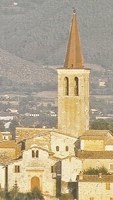
San Brizio, outside Spoleto
The story of a group of twelve Syrians who played a central role in the evangelisation of Umbria is told in a group of related legends:
-
✴the Passio et conversio ss. Anastasii et XII fratrum qui cum eo de Syriae partibus venerunt (St Anastasius and 11 brothers who came from Syria - BHL 1620 - 26th July);
-
✴the Passio ss. Abundii et Carpophori (SS Abundius and Carpophorus - BHL 1622 - 10th December), which was published by Bonino Mombrizio; and
-
✴the Passio s. Britii (St Brictius - BHL 1622d - 9th September), of which two copies survive in the Leggendari del Duomo di Spoleto.
Each of the following legends combines the figure of a particular saint with the eponymous figure in the Legend of the Twelve Syrians:
-
✴the Passio s. Herculanus ep. Perusinus (St Herculanus - BHL 3823 - 1st March);
-
✴the Passio s. Euticii Confessoris (St Eutychius - BHL ?? - 23rd May); and
-
✴the Passio s. Proculi (St Proculus - BHL 6955 - 1st June).
According to all of these accounts, the leader of the party, St Anastasius was accompanied from Syria to Rome by:
-
✴his sons:
-
•St Brictius; and
-
•St Eutychius; and
-
✴other members of his extended family:
-
•St John;
-
•St Isaac;
-
•St Teudila;
-
•St Herculanus; and
The chronology of these events is famously confused: even in the first sentence, they take place at the time of:
-
✴the Emperor Julian the Apostate, who was emperor in the west from 355 and sole emperor in the period 360-3; and
-
✴“ss. Urbano episcopo”, “ss. papa Urbano” or other variants thereof, which is usually taken to refer to Pope Urban I (died 230).
An analysis of these and other chronological inconsistencies in the legend is set out in the page on the Legend of the Twelve Syrians II.
When the party arrived in Rome, Bishop/Pope Urban ordained:
-
✴SS Brictius and Carpophorus as priests; and
-
✴SS Laurence and Abundius as deacons.
The family then embarked on a programme of evangelisation that infuriated the civic authorities. They referred the matter to the Emperor Julian, who ordered that the party should be imprisoned.
St Anastasius was subsequently beheaded, but SS Brictius and Eutychius managed to lead the rest of the family to safety along Via Cornelia. They then split up at a place called “Pax Sanctorum”:
-
✴St Eutychius settled as a hermit near lake Bolsena;
-
✴St Proculus went to Narni and continued to Carsulae;
-
✴SS Brictius led the rest of the family to Spoleto.
The subsequent stories of the individual figures are summarised on their respective pages (see the links above).
St Peter subsequently appeared to St Brictius and conferred on him authority to appoint bishops in the surrounding cities:
-
✴Two of these appointments were from the original twelve:
-
•St John became Bishop of Spoleto and built the church of San Pietro there;
-
•St Herculanus became Bishop of Perugia.
-
✴The other two appear here for the first time:
-
•St Vincent became Bishop of Bevagna;
-
•St Crispoltus became Bishop of Bettona.
Hagiographic Tradition
The documents in the Leggendari del Duomo di Spoleto fed a prolific and ever more tortuous hagiographic tradition in Umbria, particularly in the late 16th and early 17th centuries. It is unfortunate that the documents subsequently disappeared for a period, and that the Bollandists were consequently unable to consult them when they visited Spoleto in 1660. They relied instead on transcriptions, including a number that Ludovico Jacobilli gave to them.
Most of the missing documents were returned to the cathedral archives in 1683, and the Bollandist Conrad Janninck was able to travel to Spoleto in 1685 in order to examine them. This probably prompted him to revisit the lives of the “Twelve Syrians” in Volume I of the July edition of the “Acta Sanctorum”, which was first published in 1719. This material, which appears as a discrete section (out of date order) under the title “Tractatus Praeliminaris” (search on “Passio atque conversio”), which is, however, largely based on the version of the legend in the Codex Barberiniano (now in the Vatican Library). The accompanying comments contain the famous criticism of the “fumosa fax” (smoky torch) that Ludovico Jacobilli had brandished as he embellished the legends, so that he had (inadvertently) misled the earlier Bollandists.
The status of the Legend of the Twelve Syrians was badly affected by negative judgement of the Bollandists, which particularly relates to the absurd chronology of the events described in it. This negative judgement has persisted over the centuries. Nevertheless, the legend provides fascinating glimpses into the history of Christianity in Umbria, albeit that they are difficult to interpret.
Untangling the Legend
As Emore Paoli (see reference below in 2000) has pointed out, it is likely that the legend is actually a “patchwork” of separate legends, each of which was originally coherent in its chronology. The collection was probably put together for “political” reasons, but these are now difficult to discern, particularly since the identity of the author(s) and the date and place at which it was first compiled are all still matters of conjecture.
The analysis in the pages that follow attempts to separate the “patchwork” into its component “patches” and thus to identify the inspiration for the most important of the twelve “Syrians”. Some ideas about the circumstances in which these patches were sewn together are then set out.
Please be aware that what follows are the speculations of an amateur. If you have a serious interest, you would do well to consult the sources referenced below.









